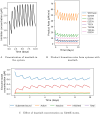Beyond IC50-A computational dynamic model of drug resistance in enzyme inhibition treatment
- PMID: 39509464
- PMCID: PMC11575782
- DOI: 10.1371/journal.pcbi.1012570
Beyond IC50-A computational dynamic model of drug resistance in enzyme inhibition treatment
Abstract
Resistance to therapy is a major clinical obstacle to treatment of cancer and communicable diseases. Drug selection in treatment of patients where the disease is showing resistance to therapy is often guided by IC50 or fold-IC50 values. In this work, through a model of the treatment of chronic myeloid leukaemia (CML), we contest using fold-IC50 values as a guide for treatment selection. CML is a blood cancer that is treated with Abl1 inhibitors, and is often seen as a model for targeted therapy and drug resistance. Resistance to the first-line treatment occurs in approximately one in four patients. The most common cause of resistance is mutations in the Abl1 enzyme. Different mutant Abl1 enzymes show resistance to different Abl1 inhibitors and the mechanisms that lead to resistance for various mutation and inhibitor combinations are not fully known, making the selection of Abl1 inhibitors for treatment a difficult task. We developed a model based on information of catalysis, inhibition and pharmacokinetics, and applied it to study the effect of three Abl1 inhibitors on mutants of the Abl1 enzyme. From this model, we show that the relative decrease of product formation rate (defined in this work as "inhibitory reduction prowess") is a better indicator of resistance than an examination of the size of the product formation rate or fold-IC50 values for the mutant. We also examine current ideas and practices that guide treatment choice and suggest a new parameter for selecting treatments that could increase the efficacy and thus have a positive impact on patient outcomes.
Copyright: © 2024 Roadnight Sheehan et al. This is an open access article distributed under the terms of the Creative Commons Attribution License, which permits unrestricted use, distribution, and reproduction in any medium, provided the original author and source are credited.
Conflict of interest statement
The authors have declared that no competing interests exist.
Figures








Similar articles
-
The catalytic activity of Abl1 single and compound mutations: Implications for the mechanism of drug resistance mutations in chronic myeloid leukaemia.Biochim Biophys Acta Gen Subj. 2019 Apr;1863(4):732-741. doi: 10.1016/j.bbagen.2019.01.011. Epub 2019 Jan 24. Biochim Biophys Acta Gen Subj. 2019. PMID: 30684523
-
Axitinib effectively inhibits BCR-ABL1(T315I) with a distinct binding conformation.Nature. 2015 Mar 5;519(7541):102-5. doi: 10.1038/nature14119. Epub 2015 Feb 9. Nature. 2015. PMID: 25686603
-
Finding the right BCR-ABL1 tyrosine kinase inhibitor: a case report of successful treatment of a patient with chronic myeloid leukemia and a V299L mutation using nilotinib.BMC Cancer. 2018 Nov 12;18(1):1097. doi: 10.1186/s12885-018-5004-3. BMC Cancer. 2018. PMID: 30419862 Free PMC article.
-
ABL1-Directed Inhibitors for CML: Efficacy, Resistance and Future Perspectives.Anticancer Res. 2020 May;40(5):2457-2465. doi: 10.21873/anticanres.14215. Anticancer Res. 2020. PMID: 32366389 Review.
-
Mechanisms of Resistance to ABL Kinase Inhibition in Chronic Myeloid Leukemia and the Development of Next Generation ABL Kinase Inhibitors.Hematol Oncol Clin North Am. 2017 Aug;31(4):589-612. doi: 10.1016/j.hoc.2017.04.007. Hematol Oncol Clin North Am. 2017. PMID: 28673390 Free PMC article. Review.
Cited by
-
A computational dynamic model of combination treatment for type II inhibitors with asciminib.Protein Sci. 2025 Aug;34(8):e70219. doi: 10.1002/pro.70219. Protein Sci. 2025. PMID: 40671559 Free PMC article.
-
Ciprofol suppresses glycolysis and EMT in colorectal cancer cells by activating APC to modulate the Wnt/β-catenin signaling pathway.Sci Rep. 2025 Jul 20;15(1):26354. doi: 10.1038/s41598-025-08652-5. Sci Rep. 2025. PMID: 40685385 Free PMC article.
References
MeSH terms
Substances
LinkOut - more resources
Full Text Sources
Medical
Miscellaneous

